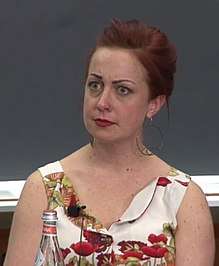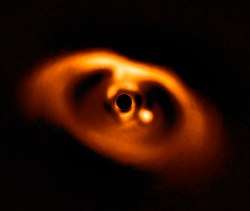Sarah Ballard
Sarah Ballard (born 1984[1]) is an American Professor of Astronomy currently at the University of Florida.[2] She has been a Torres Fellow at the Massachusetts Institute of Technology,[3][4] a L'Oreal Fellow,[5] and a NASA Carl Sagan Fellow.[6]
Sarah Ashley Ballard | |
|---|---|
 Sarah Ballard in 2017 | |
| Born | 1984 (age 35–36) |
| Education | B.A. Astrophysics, UC Berkeley Ph.D. Astronomy and Astrophysics, Harvard (2012) |
| Known for | Discovery of Kepler-19c (first exoplanet by transit-timing variation) |
| Scientific career | |
| Fields | Exoplanetary astrophysics |
| Thesis | In Pursuit of New Worlds: Searches for and Studies of Transiting Exoplanets from Three Space-Based Observatories (2012) |
| Doctoral advisor | David Charbonneau |
| Website | drballard |
Ballard was part of a collaborative team that was the first to successfully use the transit-timing variation method. This resulted in her team's confirmation of this theoretical search procedure and the discovery of the Kepler-19 planetary system with that technique.[7] Ballard took part in the discovery of four exoplanets (early numbered) in the Kepler spacecraft mission prior to its finding of significant quantities of planets around other stars.
Ballard has spoken about her experience as a victim of sexual harassment,[8][9] about imposter syndrome, and about the controversy over the proposed Thirty Meter Telescope at the Mauna Kea Observatories.
Education
As an undergraduate, Ballard started out as a gender studies major at the University of California, Berkeley.[10][11] She completed a bachelor's degree from Berkeley in astrophysics in 2007, with a minor in physics.[12] She did her graduate studies at Harvard University, completing a doctorate in astronomy and astrophysics in 2012 under the supervision of David Charbonneau.[12]
Fellowships
Ballard was a NASA Carl Sagan Fellow at the University of Washington where she did postdoctoral work;[6] and in 2015 was awarded a Women in Science Fellows postdoctoral fellowship by L'Oréal USA to continue her research at MIT.[5]
Exoplanet discoveries
Ballard took part in the discovery of four exoplanets before she turned 30 years old, including Kepler-19c, the first exoplanet found using the transit-timing variation method on data from the Kepler mission.[10][13][14]
| Planet Discoveries of Sarah Ballard | |||||||||
|---|---|---|---|---|---|---|---|---|---|
| Planets Discovered: 4 | |||||||||
| Number | Planet Designation |
Type | Size Class | System | Constellation | Discoverer(s) | Year | Discovery Method | Telescope |
| 1 | Kepler-19b[14] | Exoplanet | Kepler-19 | Lyra | Sarah Ballard et al. | Transit | Kepler | ||
| 2 | Kepler-61b[14] | Exoplanet | Kepler-61 | Lyra | Sarah Ballard et al. | Transit | Kepler | ||
| 3 | Kepler-93b[14] | Exoplanet | Super-Earth[15][16] | Kepler-93 | Lyra | Sarah Ballard et al. | Transit | Kepler | |
| 4 | Kepler-19c | Exoplanet | Kepler-19 | Lyra | Sarah Ballard et al. | 2011 | Transit-timing variation | Kepler | |
| Table Legend: | |||||||||
|
Size class = Planet radius distribution (radius of Earth).[17] |
Discovery method =
| ||||||||
Transit-timing variation
The transit-timing variation method (TTV) is one of two techniques, along with the transit-duration variation method, proposed in 2001 by astronomer Jordi Miralda-Escudé.[18] TTV was amplified upon in 2004 by astronomers Matthew J. Holman and Norman W. Murray;[19] and by Eric Agol, Jason Steffen, Re’em Sari, and Will Clarkson.[20] Ballard was the principal investigator in the 2009 application to use the Spitzer Space Telescope to examine "The First Exoplanet Smaller than the Earth".[21] Ballard led the team which precisely estimated the diameter of Kepler-93b to within 1 percent, using TTV.[15][22]
Activism
When exoplanetologist Geoffrey Marcy resigned from the UC Berkeley faculty over charges that he had sexually harassed female undergraduate students, Ballard came out publicly as one of his victims in order to help bring attention to sexual harassment in academia.[23][24][25] In an interview published by Wired, she said that "In the parking lot outside her apartment [...] he gave her advice about her current relationship. She opened the door and stuck her legs out, eager to leave. [...] He put his hand on the back of her neck and told her to relax, that everything would work out with that boy".[26]
Ballard has written and conducted workshops on impostor syndrome.[27][28][29][30] She was involved in a controversy about the proposed Thirty Meter Telescope at Mauna Kea Observatory. Her friend, Keolu Fox, a native Hawaiian, helped her see the issue from an indigenous perspective.[31] Ballard spoke about the issue despite fears about the effects it may have on her career.[31]
Ballard was one of a number of scientists who expressed concern in "An open letter to SCOTUS from professional physicists drafted by the Equity & Inclusion in Physics & Astronomy group"[32] following oral arguments in the U.S. Supreme Court case commonly known as Fisher II involving inclusiveness in admissions policies at the University of Texas.
See also
References
- Sarah Ballard, "Directions to the Nearest Alien Earth-like Planet" on YouTube, NYU Special [Public] Colloqium, 2013 October 11.
- University of Florida, Department of Astronomy Faculty
- Rodulfo, Kristina (October 13, 2015), "Meet 5 Scientists Paving the Path for Women in STEM: L'Oréal announces recipients of the For Women in Science Fellowship", Elle
- Speier, Jackie (July 13, 2016), "Congresswoman Speier to Host Discussion about Sexual Harassment in Science", United States House of Representatives official website
- L'Oréal USA Announces 2015 For Women in Science Fellows, L'Oréal USA, October 13, 2015
- Sagan Postdoctoral Fellow and Michelson Fellow Recipients: 2012 Class of Sagan Fellows, NASA Exoplanet Science Institute at Caltech, retrieved 2017-10-18
- Ballard, Sarah; et al. (2011), "The Kepler-19 System: A Transiting 2.2 R⊕ Planet and a Second Planet Detected via Transit Timing Variations", The Astrophysical Journal, 743 (2): 200, arXiv:1109.1561, Bibcode:2011ApJ...743..200B, doi:10.1088/0004-637X/743/2/200
- "Was UC Berkeley too easy on professor accused of sexual harassment?". Christian Science Monitor. 14 October 2015.
- Overbye, Dennis (10 October 2015). "Geoffrey Marcy, Astronomer at Berkeley, Apologizes for Behavior". The New York Times.
- Bell, Rachel (September 10, 2014), Seattle astronomer discovers four planets before she turns 30, KIRO radio, archived from the original on 2015-04-20
- Meinbresse, Debbie (November 13, 2015). "3Q: Sarah Ballard on astrophysics and gender equity in science". MIT News.
- Curriculum vitae: Sarah Ballard (PDF), retrieved 2015-10-13
- Wall, Mike (September 8, 2011), Stealth Alien Planet Discovered By New Technique, Space.com
- Uitti, Jake (October 15, 2014), "The Seattle astronomer who discovered 4 planets before age 30", Crosscut
- Phillips, Tony (August 19, 2014). "Exoplanet measured with remarkable precision". NASA Science News. Retrieved 16 May 2016.
A team led by Sarah Ballard...
- O'Neill, Ian (July 25, 2014). "Most Precise Measurement of an Alien World Achieved". Discovery.com. Retrieved 16 May 2016.
- Sarah Ballard, "Exoplanet Validation by Asteroseismology" on YouTube, NYU Physics Colloqium, 2013 October 10.
- Miralda-Escudé, Jordi (2001), "Orbital perturbations of transiting planets: A possible method to measure stellar quadrupoles and to detect Earth-mass planets", 2001 arXiv: 0104034; 2002 ApJ 564 1019.
- Holman, Matthew J.; and Murray, Norman W. (2004), "The Use of Transit Timing to Detect Extrasolar Planets with Masses as Small as Earth", 2004 arXiv: 0412028; 2005 Science 307 1288.
- Agol, Eric; Steffen, Jason; Sari, Re'em; and Clarkson, Will (2004), "On detecting terrestrial planets with timing of giant planet transits"; 2004 arXiv: 0412032; 2005 MNRAS 359 567.
- "Spitzer Space Telescope - Directors Discretionary Time Proposal #541". Spitzer Science Center. Retrieved 16 May 2016.
- "Astrophysics: Best gauge of exoplanet size". Nature. 512 (7512): 9. 2014. Bibcode:2014Natur.512R...9.. doi:10.1038/512009b.
- "UC Berkeley astronomy professor quits amid sexual harassment allegations". The Guardian. October 14, 2015.
- Pohle, Allison (October 16, 2015). "Local astronomer helped bring attention to issue of sexual harassment in science". Boston.com.
- Kleinfeld, Zoe (October 15, 2015). "Light shed on a dark matter". Daily Californian.
- "What Happens When a Harassment Whistleblower Goes on the Science Job Market". Wired. 2016-07-17. Retrieved 2016-07-17.
- Ballard, Sarah, "Impostor syndrome workshop", Official website, University of Washington Dept. of Astronomy
- Ballard, Sarah (2011), The Mismeasure of Woman, Scientista Foundation
- Pratt, Katherine (October 7, 2015), Tips to Defeat Your Inner Imposter, Center for Sensorimotor Neural Engineering
- Wright, Jason T. (June 2, 2015), "Impostor syndrome", blog, Pennsylvania State University
- Lemonick, Michael (April 18, 2015). "INSIGHT Mauna Kea Controversy". New Scientist. 226 (3017): 1. Retrieved 14 May 2016 – via EBSCO.
- https://eblur.github.io/scotus/ , entry 901.
External links
- Official website
- I Parasailed Planet KOI 314.02 And All I Got Was This Lousy T-Shirt, The Takeaway (radio show), March 3, 2015, guest Sarah Ballard
- The Most Precise Measurement of an Alien World's Size, NASA Jet Propulsion Laboratory, July 24, 2014,
Ballard and her team have made a major scientific advance...
